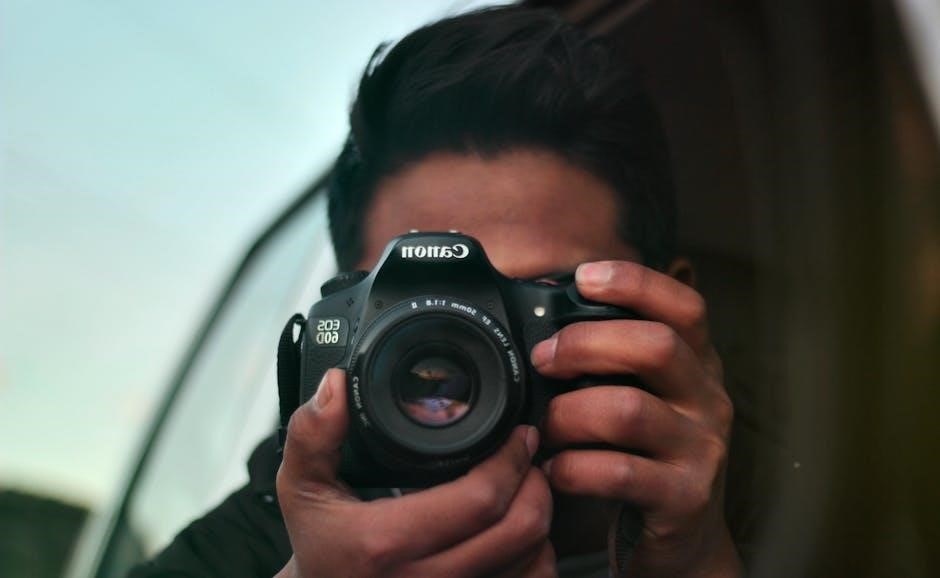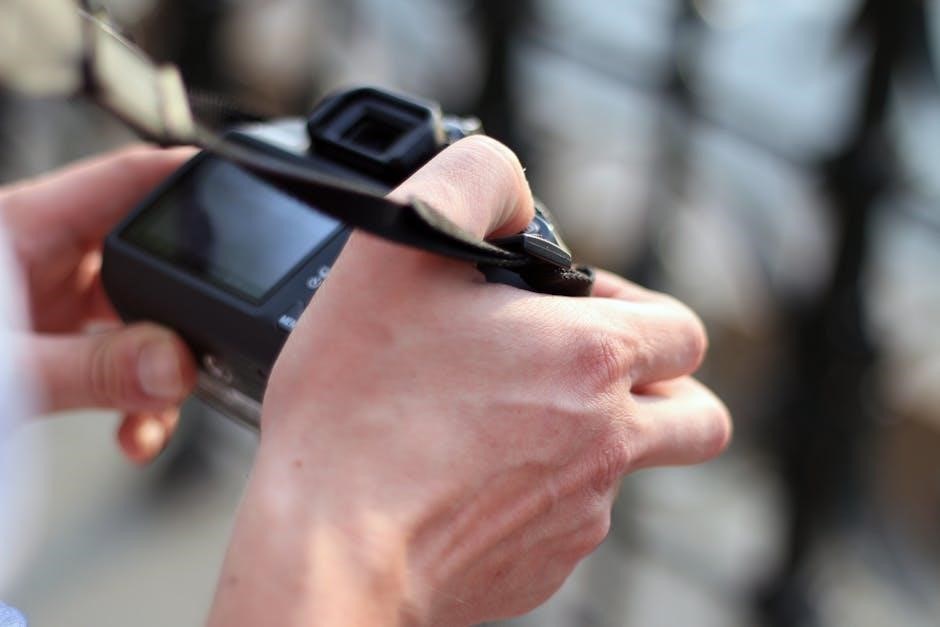Canon Rebel T3i Manual: A Comprehensive Guide
Welcome to your definitive resource for mastering the Canon EOS Rebel T3i! This guide compiles essential information, offering links to manuals, firmware updates, and service resources. Whether troubleshooting, repairing, or simply exploring features, find detailed instructions and expert advice here. Unlock your camera’s full potential today!
The Canon EOS Rebel T3i, also known as the EOS 600D, is a versatile digital SLR camera renowned for its user-friendly interface and impressive image quality. This camera is an excellent choice for both beginners venturing into the world of photography and experienced enthusiasts seeking a reliable and capable tool.
This comprehensive guide is designed to navigate you through every aspect of the T3i, from basic setup to advanced techniques. We will explore its key features, including various shooting modes, focusing systems, and exposure settings. You’ll also learn about white balance, color settings, and how to effectively utilize the built-in flash, as well as external flash options.
Beyond still photography, the T3i excels in video recording, offering full HD capabilities. We will delve into video settings and techniques, ensuring you capture stunning videos. Furthermore, this guide covers playback and image review, troubleshooting common issues, and essential care and maintenance tips to prolong your camera’s lifespan.
By the end of this guide, you’ll possess a thorough understanding of your Canon Rebel T3i, enabling you to confidently capture breathtaking photos and videos in any situation. Let’s embark on this photographic journey together!
Basic Camera Setup and Initial Settings

Before diving into the creative aspects of photography, it’s crucial to properly set up your Canon Rebel T3i. Start by inserting a charged battery and a compatible SD card. The battery compartment is located at the bottom, while the SD card slot is usually on the side.

Next, power on your camera using the power switch. The initial setup screen will guide you through setting the date, time, and language. Accurate date and time settings are essential for organizing your photos and videos.
Now, let’s configure some basic settings. Navigate to the camera’s menu using the “Menu” button. Here, you can adjust the image quality settings. For general photography, a high-quality JPEG setting is recommended. If you prefer maximum editing flexibility, consider shooting in RAW format.
Another important setting is the Auto Power Off feature. Adjusting this setting helps conserve battery life by automatically turning off the camera after a period of inactivity. Finally, familiarize yourself with the diopter adjustment near the viewfinder to ensure a clear and sharp view.
These initial steps lay the foundation for optimal camera performance and a seamless shooting experience. With these settings in place, you’re ready to explore the creative possibilities of your Canon Rebel T3i.
Understanding Shooting Modes
The Canon Rebel T3i offers a variety of shooting modes to cater to different photographic situations and skill levels. Understanding these modes is key to unlocking your camera’s full potential. The mode dial, located on the top of the camera, allows you to select the desired shooting mode.
Auto Mode: This is the most basic mode, where the camera automatically adjusts all settings for optimal results. It’s perfect for beginners or when you need to quickly capture a moment without worrying about manual adjustments.
Creative Auto (CA) Mode: This mode offers a simplified way to adjust settings like background blur and brightness, making it easy to achieve creative effects without technical knowledge.
Program (P) Mode: This mode allows you to set the ISO and white balance, while the camera automatically selects the aperture and shutter speed. It offers more control than Auto mode while still providing some automation.
Aperture Priority (Av) Mode: In this mode, you set the aperture, which controls the depth of field, and the camera automatically selects the appropriate shutter speed. This is ideal for controlling background blur in portraits or landscapes.
Shutter Priority (Tv) Mode: Here, you set the shutter speed, which controls motion blur, and the camera automatically selects the aperture. This is useful for capturing fast-moving subjects or creating motion blur effects.
Manual (M) Mode: This mode gives you complete control over both aperture and shutter speed, allowing for maximum creative flexibility. It requires a good understanding of exposure principles.
Scene Modes: The T3i also offers various scene modes like Portrait, Landscape, Macro, and Sports, which optimize settings for specific shooting scenarios.
Movie Mode: This mode allows you to record videos with the T3i.
By experimenting with these different shooting modes, you’ll gain a better understanding of how aperture, shutter speed, and ISO affect your images, and you’ll be able to capture the perfect shot in any situation.
Focusing System and Techniques
The Canon Rebel T3i boasts a reliable autofocus system essential for capturing sharp and clear images. Understanding its features and techniques will significantly improve your photography. The T3i employs a 9-point autofocus system, meaning it has nine focus points spread across the viewfinder, allowing you to select the most appropriate point for your subject.
Autofocus Modes: The camera offers different autofocus modes to suit various shooting situations. One-Shot AF is ideal for stationary subjects. When the shutter button is pressed halfway, the camera focuses and locks onto the subject. AI Focus AF intelligently switches between One-Shot and AI Servo depending on whether the subject is moving or stationary. AI Servo AF is designed for moving subjects, continuously adjusting focus as the subject moves.
Focus Point Selection: You can manually select a focus point or allow the camera to automatically select one. Manual selection provides greater control, especially when your subject is off-center. To manually select a focus point, press the AF point selection button and use the directional buttons to choose your desired point.
Focusing Techniques: Back-button focusing, involves assigning the autofocus function to a button on the back of the camera (typically the AE lock button). This separates focusing from the shutter button, allowing you to focus once and then recompose your shot without refocusing. Focus and recompose is another technique where you focus on your subject, then recompose the shot while maintaining the shutter button pressed halfway.
Mastering these focusing techniques will enable you to capture sharper images, especially in challenging situations; Experiment with different autofocus modes and focus point selections to find what works best for your shooting style.
Exposure Settings: Aperture, Shutter Speed, and ISO
Understanding the interplay between aperture, shutter speed, and ISO is crucial for achieving well-exposed photographs with your Canon Rebel T3i. These three elements form the exposure triangle, each influencing both the brightness and creative aspects of your images. Mastering them allows you to control depth of field, motion blur, and image noise.
Aperture: Aperture refers to the opening in the lens through which light passes. It is measured in f-stops (e.g., f/2.8, f/8, f/16). A wider aperture (smaller f-number) lets in more light, creating a shallow depth of field, ideal for portraits with blurred backgrounds. A narrower aperture (larger f-number) lets in less light, resulting in a greater depth of field, suitable for landscapes where everything is in focus.
Shutter Speed: Shutter speed is the duration the camera’s shutter remains open, exposing the sensor to light. It’s measured in seconds or fractions of a second (e.g., 1/1000s, 1/60s, 1s). Fast shutter speeds freeze motion, while slow shutter speeds create motion blur, useful for capturing light trails or a sense of movement.
ISO: ISO represents the camera’s sensitivity to light. Lower ISO values (e.g., ISO 100) produce cleaner images with less noise but require more light. Higher ISO values (e.g., ISO 3200) are useful in low-light situations but introduce more image noise or grain.
White Balance and Color Settings
Achieving accurate colors in your photographs with the Canon Rebel T3i relies heavily on understanding white balance and color settings. White balance ensures that white objects appear white in your images, regardless of the color temperature of the light source. Incorrect white balance can result in unwanted color casts, making images appear too warm (yellowish) or too cool (bluish).
The Rebel T3i offers several white balance presets, including Auto (AWB), Daylight, Shade, Cloudy, Tungsten, Fluorescent, and Flash. The Auto White Balance generally performs well in many situations, but selecting the appropriate preset for the lighting conditions will yield more accurate results. For example, use the Tungsten preset when shooting indoors under incandescent lighting to counteract the warm tones.
In addition to presets, you can also use Custom White Balance. This involves taking a photo of a white or gray object under the specific lighting conditions and then setting that image as the custom white balance reference. This method provides the most accurate color reproduction in challenging lighting situations.
Furthermore, the Rebel T3i offers Picture Styles, which affect the overall color and contrast of your images. Options include Standard, Portrait, Landscape, Neutral, Faithful, and Monochrome. Experiment with these styles to find the look that best suits your creative vision. You can fine-tune the sharpness, contrast, saturation, and color tone of each Picture Style to personalize your images further.
Using the Built-in Flash and External Flash Options
The Canon Rebel T3i features a built-in flash, a convenient tool for adding light to your photos in low-light situations. To activate the built-in flash, simply press the flash button located on the camera body. The flash will automatically fire when the camera determines it’s needed in modes like Auto or Scene modes. In Creative Zone modes (Av, Tv, M), you have more control over the flash settings;
You can adjust the flash exposure compensation to fine-tune the flash output. This allows you to increase or decrease the flash intensity to achieve the desired lighting effect. Experiment with different flash compensation values to avoid overexposed or underexposed images.
For more advanced lighting control, the Rebel T3i also supports external flash units. An external flash offers several advantages over the built-in flash, including greater power, faster recycle times, and the ability to bounce the flash off ceilings or walls for softer, more natural lighting. Canon’s Speedlite flashes are fully compatible with the Rebel T3i and offer various features, such as E-TTL II flash metering for accurate exposure.
When using an external flash, you can control it through the camera’s menu system. This allows you to adjust the flash mode, flash exposure compensation, and other settings. With an external flash, you can explore creative lighting techniques like off-camera flash and high-speed sync to capture stunning images in various situations.
Recording Videos with the Canon Rebel T3i
The Canon Rebel T3i empowers you to capture high-definition videos with ease. To start recording, set the Mode Dial to the movie mode icon. Then, press the Live View button to activate the screen, and finally press the Start/Stop button to begin filming. The Rebel T3i records in Full HD (1920×1080) resolution, delivering sharp and detailed video footage.
During video recording, you can manually adjust exposure settings like aperture, shutter speed, and ISO to control the brightness and depth of field. Experiment with different settings to achieve the desired cinematic look. The T3i also features a built-in microphone for capturing audio, but for higher-quality sound, consider using an external microphone connected to the camera’s microphone input.
Autofocus is available during video recording, but it’s important to note that the continuous autofocus can sometimes be noisy or cause the image to hunt for focus. For smoother and more professional-looking video, consider using manual focus. You can also adjust the white balance settings to ensure accurate colors in your videos.
The Rebel T3i records videos in the MOV format, which is compatible with most video editing software. When shooting video, it’s crucial to use a fast SD card to ensure smooth recording without interruptions. A Class 10 SD card is recommended for Full HD video recording. With the Canon Rebel T3i, capturing memorable moments in video is both accessible and enjoyable.
Playback and Image Review
The Canon Rebel T3i offers intuitive playback and image review features, allowing you to instantly assess your shots. To access playback mode, simply press the Playback button located on the camera’s rear panel. The last captured image will appear on the LCD screen, ready for review.
Use the Main Dial to scroll through your images, moving forward or backward through your photo library; The T3i also offers a variety of display options during playback. Pressing the Info button will cycle through different display modes, showing various shooting data such as aperture, shutter speed, ISO, and histogram. The histogram provides a visual representation of the image’s tonal range, helping you evaluate exposure accuracy.
You can zoom in on images to check for sharpness and detail by pressing the zoom in button. Use the multi-controller to navigate around the zoomed-in area. To zoom out, press the zoom out button. The T3i also allows you to delete unwanted images directly from the camera. Press the Delete button, and confirm your selection to remove the image from your memory card.
The image review feature is invaluable for learning and improving your photography skills. By analyzing the shooting data and histogram, you can gain insights into how different settings affect your images. Additionally, the zoom function lets you examine the sharpness and focus of your shots, enabling you to make necessary adjustments in future shoots. This immediate feedback loop is essential for mastering your Canon Rebel T3i.
Troubleshooting Common Issues
Encountering issues with your Canon Rebel T3i is not uncommon, but most problems can be easily resolved with a few troubleshooting steps. One frequent issue is the camera failing to turn on. Ensure the battery is fully charged and properly inserted. If the problem persists, try cleaning the battery contacts with a dry cloth.
Another common concern is blurry images. Check your focus settings and ensure you’re using an appropriate shutter speed for the shooting conditions. Inadequate lighting can also contribute to blur, so consider increasing the ISO or using a flash. If your images appear overexposed or underexposed, review your aperture, shutter speed, and ISO settings. Adjust these parameters to achieve the desired exposure level.
If you encounter error messages on the LCD screen, consult your Canon Rebel T3i manual for specific troubleshooting instructions related to that error code. Error messages often indicate issues with the memory card, lens, or internal camera functions. When the camera is not reading the memory card, try reformatting the card. Sometimes, the lens is not attached correctly. So, reattaching the lens might solve the issue.
If you’re experiencing difficulties with autofocus, make sure the lens is set to AF mode and that the subject is within the focusing range. For persistent problems, resetting the camera to its factory defaults can sometimes resolve software-related glitches. By systematically addressing these potential issues, you can quickly diagnose and fix many common problems with your Canon Rebel T3i.
Care and Maintenance of Your Canon Rebel T3i
Proper care and maintenance are crucial for extending the life and performance of your Canon Rebel T3i. Start by regularly cleaning the camera body and lens with a soft, dry cloth to remove dust and fingerprints. For stubborn smudges, lightly dampen the cloth with a lens cleaning solution, but avoid applying liquid directly to the camera or lens.
Protect your camera from physical damage by storing it in a padded camera bag when not in use. Avoid exposing the camera to extreme temperatures, humidity, or direct sunlight for prolonged periods, as these conditions can damage the internal components. Regularly inspect the lens for scratches, dust, or fungus. Use a blower to remove loose particles, and consider professional cleaning for more serious issues.
When changing lenses, ensure the camera is turned off to prevent damage to the sensor or lens mount. Handle memory cards with care, and avoid bending or scratching them. Always format memory cards inside the camera to ensure compatibility and prevent data corruption. Keep the battery contacts clean to maintain optimal power delivery.
Periodically check and update the camera’s firmware to ensure it’s running the latest software. This can improve performance and address any known bugs. By following these simple care and maintenance tips, you can keep your Canon Rebel T3i in top condition and enjoy years of reliable use.
